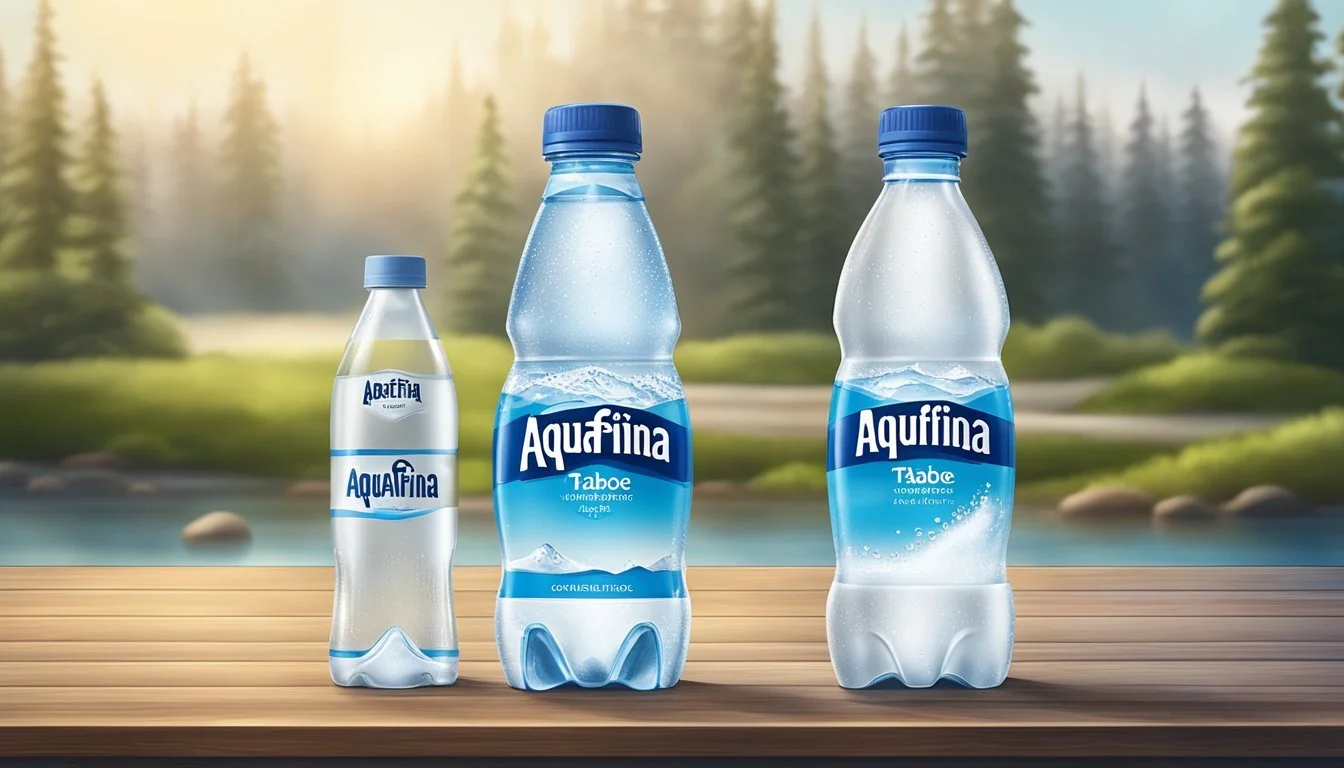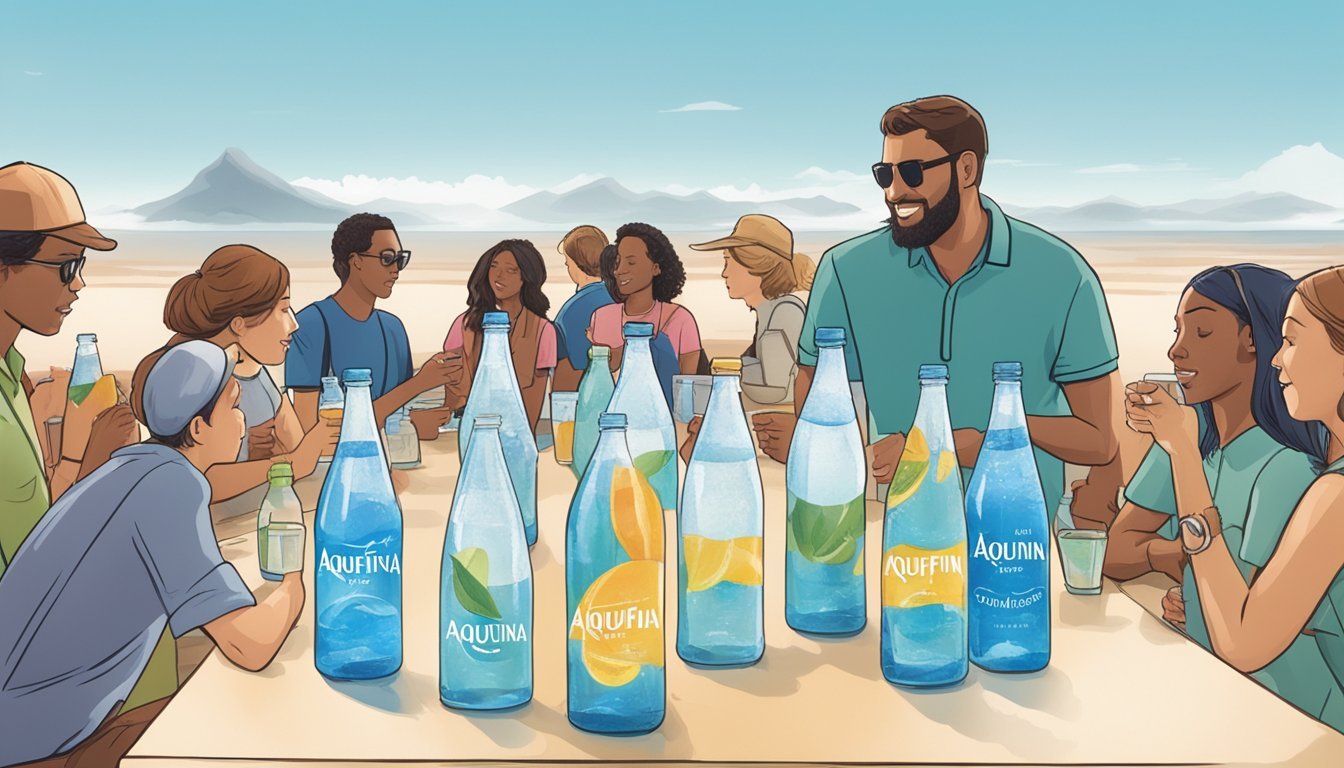Aquafina vs. Tahoe
Comparing Taste, Purity, and Value
When it comes to choosing between Aquafina and Tahoe bottled water, the decision ultimately boils down to taste, sourcing, and brand reputation. Aquafina, produced by PepsiCo, is widely recognized for its purity and crisp taste. Its filtration process, which removes impurities and minerals, ensures a consistently clean and refreshing experience.
Tahoe, on the other hand, prides itself on a more natural approach. Sourced from pristine natural springs, Tahoe water offers a subtly different flavor profile that some consumers find more appealing. For those who prefer water with a hint of natural minerals, Tahoe may stand out as the better choice.
Ultimately, the best choice between Aquafina and Tahoe depends on personal preference. While some might appreciate Aquafina’s reliably clean taste, others may find Tahoe’s spring-sourced water more refreshing. Both brands have their merits, making it a tough decision for any bottled water enthusiast.
The Importance of Hydration
Hydration is crucial for maintaining overall health and ensuring the body functions optimally. Water plays a key role in numerous bodily processes and offers numerous health benefits.
Health Benefits of Drinking Water
Proper hydration helps regulate body temperature. This is essential for preventing overheating, especially during physical activities. Water also supports kidney function by aiding in the elimination of waste and toxins from the body.
Furthermore, drinking sufficient water can improve skin health. It helps maintain skin elasticity and reduces the likelihood of dryness and wrinkles.
Adequate water intake also promotes cardiovascular health. It supports blood volume and circulation, reducing the risk of heart stress.
Role of Water in the Body
Water is fundamental to digestion and nutrient absorption. It aids in breaking down food so nutrients can be effectively absorbed. Without adequate water, the digestive process can become inefficient.
Additionally, water acts as a lubricant for joints and tissues. This helps prevent injuries and maintain joint health. It also supports the cushioning of the brain and spinal cord.
Finally, water is essential for cellular function. It aids in the transportation of nutrients and oxygen to cells and helps remove metabolic waste, ensuring cells operate efficiently.
Understanding Bottled Water
Consumers often question the differences between various bottled water brands, their safety standards, and their environmental impact. This section provides detailed insights into the nuances of bottled water to help make informed decisions.
Types of Bottled Water
Bottled water comes in several types, distinguished mainly by their source and treatment processes. Spring water is collected from natural springs and may undergo minimal processing. Purified water, like Aquafina, undergoes stringent purification procedures, such as reverse osmosis, to remove impurities. Mineral water contains naturally occurring minerals and is typically sourced from mineral springs. Sparkling water is carbonated, either naturally or by adding carbon dioxide. Each type offers different taste experiences and health benefits, catering to varied consumer preferences.
Regulations and Safety
In the United States, the FDA regulates bottled water under the Federal Food, Drug, and Cosmetic Act, ensuring that it meets standards comparable to the EPA regulations for tap water. Bottled water must undergo rigorous testing for contaminants and proper labeling. Additionally, water brands often implement extra purification steps to exceed regulatory requirements. Aquafina, for instance, utilizes a seven-step purification process that enhances its safety and purity. This regulatory oversight guarantees that bottled water is safe for consumption, though some concerns persist about microplastics and chemical leaching from packaging.
Environmental Impact of Bottled Water
The environmental impact of bottled water is a significant concern. The production, transportation, and disposal of plastic bottles contribute to pollution and resource depletion. While some water brands are beginning to use eco-friendly packaging, such as recycled PET or biodegradable materials, the recycling rate for plastic bottles remains low. According to various reports, millions of tons of plastic waste end up in oceans and landfills annually. Companies like Aquafina are making strides by using lightweight, recyclable bottles and promoting recycling initiatives. However, the low overall recycling rates underscore the need for increased consumer awareness and better waste management practices to mitigate the environmental footprint of bottled water.
Aquafina: Purified Water
Aquafina, a product by PepsiCo, is known for its extensive purification process and consistent water quality. This section delves into the details of Aquafina's filtration methods and the resulting taste and quality of the water.
Filtration Process
Aquafina undergoes a rigorous filtration process known as HydRO-7. This method employs reverse osmosis, which is highly effective in removing impurities. Reverse osmosis uses a semi-permeable membrane to eliminate contaminants and unwanted particles, ensuring the water is close to pure.
Additionally, the HydRO-7 process involves several stages. These include carbon filtration, UV treatment, and ozone sterilization. The combination of these steps helps remove dissolved solids, organic compounds, and harmful microorganisms. PepsiCo claims this multi-step process ensures that Aquafina remains one of the purest bottled waters available on the market.
Taste and Quality
Aquafina is often praised for its clean and refreshing taste. The rigorous filtration process removes minerals and other impurities that can affect flavor. Consumers frequently note the absence of any chemical or plastic aftertaste, which is common in other bottled waters.
Aquafina also maintains a neutral pH level, typically close to 7. This neutrality ensures the water is neither too acidic nor too alkaline. Many people prefer this neutral taste as it does not overpower the palate. Consistent quality is another hallmark, with PepsiCo ensuring the same level of purity in every bottle.
The result is a bottled water that many find reliably refreshing and pure, making it a popular choice for daily hydration.
Tahoe: Natural Spring Water
Tahoe Natural Spring Water is sourced from an exceptional environment and contains a unique blend of minerals. The following sections delve into its source and origin, as well as its mineral content and health considerations.
Source and Origin
Tahoe Natural Spring Water is harvested from pristine mountain springs located in the Sierra Nevada region. This area is known for its clean and unspoiled natural resources, ensuring that the water remains pure and uncontaminated.
The water undergoes minimal processing to maintain its natural qualities. Captured at the source, it avoids possible contamination from external elements during transportation.
The Sierra Nevada’s ecosystem is integral to the water’s quality. Seasonal snowmelt and rainfall replenish these springs, contributing to the water’s unique taste and purity. The commitment to preserving this environment ensures that Tahoe maintains its high standards.
Mineral Content and Health Considerations
Tahoe Natural Spring Water contains a balanced mix of essential minerals. This includes calcium, magnesium, and potassium, all of which contribute to overall health.
Calcium: Supports bone health and muscular functions.
Magnesium: Assists in energy production and helps regulate muscle and nerve functions.
Potassium: Important for maintaining proper heart and muscle function.
These minerals not only enhance the taste but also offer health benefits. For individuals seeking a natural source of hydration with additional nutrients, Tahoe stands out.
Tahoe also boasts low sodium levels, making it a suitable choice for those monitoring their salt intake. The natural filtration through rock layers adds a subtle, clean taste that many find refreshing.
By balancing its mineral profile and keeping additives at bay, Tahoe Natural Spring Water remains a top choice for health-conscious consumers.
Comparative Analysis
Aquafina and Tahoe differ significantly in their taste profile and nutritional content. These differences are important for consumers seeking specific qualities in bottled water.
Taste Profile
Aquafina is known for its crisp, clean taste, attributed to its seven-step HydRO-7 purification process. This method effectively removes dissolved solids and impurities, resulting in a neutral flavor. In taste tests, Aquafina often scores well for its pure, almost distilled water-like taste, free from any mineral aftertaste.
Tahoe, in contrast, has a slightly more mineral-rich profile. Sourced from alpine springs, it retains naturally occurring minerals which contribute to a fresh, robust taste. This makes it a favorite for those who prefer a more "natural" taste, as it has subtle hints of the minerals present in the source water.
Nutritional Comparison
Aquafina undergoes extensive purification, which removes nearly all dissolved solids and minerals. This ensures a consistent taste but means that it has very low levels of electrolytes and other minerals. While this makes it ideal for those seeking hydration without added minerals, it may not meet the needs of those looking for electrolyte replenishment.
Tahoe, on the other hand, contains natural minerals such as calcium, magnesium, and potassium. These contribute to the water's taste and provide slight health benefits, especially for individuals looking to boost their mineral intake. The presence of these minerals can aid hydration, particularly after physical activity, by replenishing lost electrolytes.
Consumer Preferences
Consumers show specific preferences for Aquafina and Tahoe based on market trends and brand loyalty. These preferences shape buying behaviors and highlight what drives consumer choices.
Market Trends
The bottled water market has seen significant growth. Consumers increasingly favor bottled water over sugary drinks. This preference shift is influenced by health consciousness and convenience. Aquafina, backed by PepsiCo, has a strong market presence due to extensive distribution. On the other hand, Tahoe focuses on niche markets appealing to eco-conscious consumers.
Aquafina benefits from PepsiCo's extensive retail network, ensuring availability in most stores. Tahoe's focus on sustainability attracts environmentally-aware consumers who prioritize eco-friendly packaging. Recent trends suggest that flavored and mineral-enhanced waters are gaining popularity. Both brands have introduced such variants to cater to emerging demands.
Brand Perception and Loyalty
Brand perception and loyalty play crucial roles in consumer preferences. Aquafina is often perceived as a reliable and consistent choice, supported by PepsiCo's strong brand image. This perception fosters brand loyalty among consumers who prioritize familiarity.
Tahoe's brand perception is deeply tied to its commitment to sustainability. Consumers loyal to Tahoe often cite the brand's eco-friendly practices and premium quality as key factors influencing their choice. Loyalty programs and targeted marketing campaigns additionally help in retaining customers for both brands.
Coca-Cola's Dasani and Nestlé's Pure Life are also competitors influencing consumer perceptions. Each brand's unique selling propositions and marketing strategies contribute to shaping the overall dynamics of consumer preferences in the bottled water market.
The Environmental Footprint of Bottling Companies
Bottling companies have significant impacts on the environment, ranging from resource extraction to waste generation. These impacts can be mitigated by sustainable practices and consumer choices.
Sustainable Practices in Water Bottling
Water bottling companies are increasingly adopting eco-friendly practices to reduce their environmental footprint. Packaging innovations, such as using recycled materials or biodegradable options, are becoming more common.
Many companies aim to lower carbon emissions by improving energy efficiency in production plants. For example, shifting to renewable energy sources and optimizing logistics can cut down on CO2 emissions.
The Environmental Protection Agency (EPA) monitors and enforces regulations to ensure companies adhere to environmental standards. Compliance with these regulations can lead to more environmentally responsible operations.
Consumer Choices and Impact
Consumers play a vital role in driving the environmentally friendly practices of bottling companies. By choosing brands that prioritize sustainability, consumers encourage the industry to adopt better environmental standards.
Opting for water brands that disclose their environmental practices and use sustainable packaging can make a significant difference. For instance, some companies use less plastic and more recyclable materials, reducing waste.
Informed consumer choices lead to increased demand for eco-friendly products, pushing companies to invest in greener technologies and practices. This collective effort can significantly lessen the environmental impact of bottled water production and consumption.
The Health Perspective
When evaluating Aquafina and Tahoe, the health implications are crucial. Key factors include hydration levels, potential contaminants, and comparisons with tap water.
Hydration vs. Contaminants
Aquafina is a purified water brand, which undergoes a rigorous treatment process that removes most contaminants. This ensures a clean, neutral-tasting water with a balanced pH, ideal for maintaining hydration.
Tahoe, known as a spring water, is sourced from natural springs and contains natural minerals. These minerals can enhance the water's flavor and potentially provide health benefits.
Concerns about bottled water often include BPA (Bisphenol A) and PFAS chemicals (Per- and polyfluoroalkyl substances). Both Aquafina and Tahoe are marketed as BPA-free, reducing the risk of endocrine disruption. However, consumers are advised to check for any potential contaminants regularly tested by the brands.
Bottled Water vs. Tap Water
When choosing between bottled and tap water, both have distinct health implications. Aquafina's purification process often results in a cleaner product compared to many municipal tap waters, which may contain trace contaminants like chlorine and lead.
Tahoe's mineral content can offer a healthier alternative to tap water, especially if the tap water's source is questionable.
However, tap water in many regions is safe and rigorously regulated. It might also contain fluoride, which is beneficial for dental health. Nonetheless, the convenience and perceived purity of bottled options like Aquafina and Tahoe often make them preferred choices for health-conscious consumers.
In the debate of bottled versus tap, considerations include not just health, but convenience and taste preferences.
Final Considerations
When deciding between Aquafina and Tahoe bottled waters, several factors come into play, including hydration, quality, convenience, health benefits, and safety.
Summary of Findings
Aquafina uses a 7-step HydRO-7 filtration process, ensuring a high level of purification by removing many impurities often found in other bottled waters. This makes it a strong contender in terms of quality and safety.
Tahoe, though less known, is valued for its natural spring source which some consumers prefer for a more "natural" taste. Hydration levels for both remain equivalent, as both adequately meet daily intake needs.
Aquafina's filtration process also adds back mineral salts to enhance taste. Health benefits from both brands did not show a significant difference, though Aquafina's added minerals were noted to improve taste preference.
Recommendations for Consumers
For those prioritizing safety and purification, Aquafina is recommended due to its rigorous filtration process. It might be more appealing if you prefer a crisp, clean taste enhanced by mineral salts.
Tahoe might appeal more to consumers who prefer a natural spring water source without extra processing.
In terms of convenience, both brands are widely available, but Aquafina's larger market presence might make it easier to find in various retail locations. When considering health benefits, either choice is valid, but Aquafina's slightly enhanced taste could make regular consumption more pleasant.
Choose based on what fits your lifestyle and taste preferences best, bearing in mind the quality and safety features linked to each brand.








